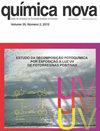O POTENCIAL DA XANTONA NATURAL α-MANGOSTINA NO DESENVOLVIMENTO DE NOVOS AGENTES ANTI-INFECCIOSOS: UMA REVISÃO
IF 0.5
4区 化学
Q4 CHEMISTRY, MULTIDISCIPLINARY
引用次数: 0
Abstract
THE POTENTIAL OF NATURAL XANTHONE α-MANGOSTIN IN THE DEVELOPMENT OF NOVEL ANTIINFECTIVE AGENTS: A REVIEW. The mangosteen (Garcinia mangostana, Linn.) is a tropical fruit cultivated in the tropical forests of Southeast Asian countries. It is recognized as the queen of fruits due to its unique color, aroma, and flavor. It has been used for centuries in Southeastern Asian traditional medicine for the treatment of various diseases. Many functional molecules with high medicinal value are obtained from the pericarp of mangosteen fruit, whose major constituent is xanthone α-mangostin. Several studies have been carried out over the last decades to further investigate and understand the pharmacological properties associated with the plant and its main chemical constituents, belonging to the class of xanthones. In addition, numerous in vitro and in vivo studies related to mangosteen have been published, indicating its importance and its potential application in medicinal chemistry. Prenylated xanthones, which include α-mangostin, are secondary metabolites particularly common in plants belonging to the Clusiaceae family. These substances have been intensively investigated for their potential as biologically active agents. This article describes a critical analysis of published data related to the properties of α-mangostin, aiming to provide a more detailed view of its potential as a chemotherapeutic agent for the prevention and treatment of infectious diseases.天然α-山竹素山酮在新型抗感染药物开发中的潜力:综述
天然山酮α-山竹苷在新型抗感染药物开发中的潜力综述。山竹(Garcinia mangostana, Linn.)是一种热带水果,种植在东南亚国家的热带森林中。由于其独特的颜色、香气和风味,它被公认为水果女王。几个世纪以来,它一直被东南亚传统医学用于治疗各种疾病。山竹果皮中含有许多具有较高药用价值的功能分子,其主要成分为山酮α-山竹苷。在过去的几十年里,人们进行了几项研究,以进一步调查和了解与这种植物及其主要化学成分相关的药理学特性,这些化学成分属于山酮类。此外,许多与山竹果有关的体外和体内研究已发表,表明其重要性及其在药物化学中的潜在应用。烯丙基化的山酮,包括α-山竹苷,是一种次生代谢产物,在藤科植物中尤为常见。这些物质作为生物活性物质的潜力已被深入研究。本文对α-山竹苷相关特性的已发表数据进行了批判性分析,旨在更详细地了解其作为预防和治疗感染性疾病的化疗药物的潜力。
本文章由计算机程序翻译,如有差异,请以英文原文为准。
求助全文
约1分钟内获得全文
求助全文
来源期刊

Quimica Nova
化学-化学综合
CiteScore
1.60
自引率
12.50%
发文量
72
审稿时长
2-4 weeks
期刊介绍:
Química Nova publishes in portuguese, spanish and english, original research articles, revisions, technical notes and articles about education in chemistry. All the manuscripts submitted to QN are evaluated by, at least, two reviewers (from Brazil and abroad) of recognized expertise in the field of chemistry involved in the manuscript. The Editorial Council can be eventually asked to review manuscripts. Editors are responsible for the final edition of QN.
 求助内容:
求助内容: 应助结果提醒方式:
应助结果提醒方式:


